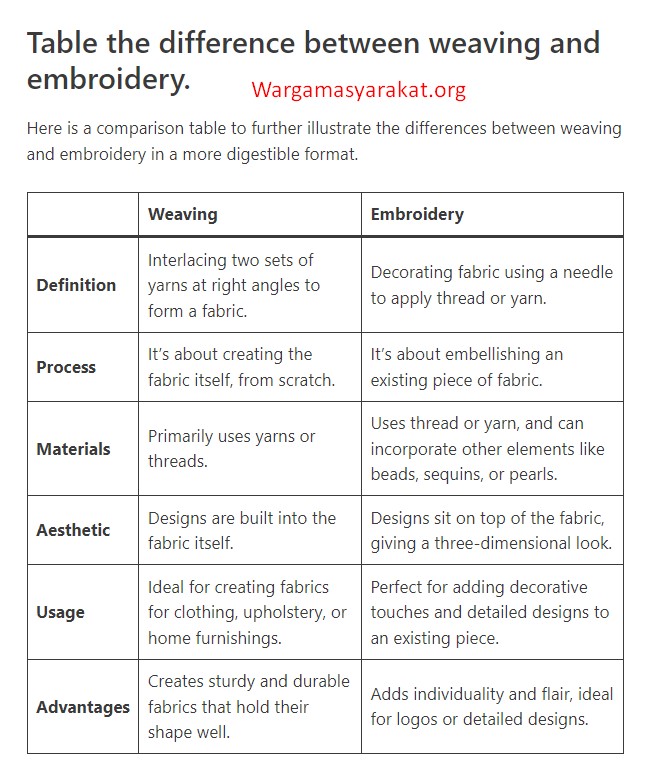explain the difference between weaving and embroidery
Daftar Isi
Weaving vs Embroidery: Understanding the Artistic Differences
Introduction
Hey there, fabric and art enthusiasts! Ever wondered what the real differences are between weaving and embroidery? Well, you’ve come to the right place! Let’s dive deep into the exciting world of textile art, specifically weaving and embroidery, and unravel the unique characteristics of each.
Understanding Weaving
Definition and Process of Weaving
First off, let’s start with weaving. In simple terms, weaving is the process of interlacing two distinct sets of yarns or threads at right angles to form a fabric. Sounds like a magic trick, right? But it’s not! It’s just an intricate and ancient method of creating cloth.
Different Types of Weaving
There are several types of weaving, such as plain weave, twill weave, and satin weave, each with its own unique texture and feel. It’s a bit like choosing a flavor at an ice cream shop, there’s something for everyone!
Advantages of Weaving
What makes weaving so great? Besides being versatile, it’s sturdy and durable, making it perfect for heavy-duty usage like in upholstery or denim jeans. Plus, woven fabrics don’t stretch easily, so they hold their shape well.
Understanding Embroidery
Definition and Process of Embroidery
Now, let’s talk about embroidery. Embroidery is the art of decorating fabric or other materials using a needle to apply thread or yarn. Picture it as painting, but instead of using a brush and colors, you’re using a needle and thread.
Different Types of Embroidery
Just like weaving, embroidery has its own variations. From Cross-Stitch to Blackwork and from Whitework to Goldwork, each type adds a unique touch and style to the fabric. It’s the icing on the cake of your fabric, making it pop and stand out!
Advantages of Embroidery
The charm of embroidery lies in its ability to add individuality and flair to any piece. It’s ideal for detailed designs and logos, adding a touch of elegance and sophistication. And because it’s typically done on already woven fabrics, the possibilities are endless!
Key Differences Between Weaving and Embroidery
Differences in Process
The most obvious difference lies in their processes. While weaving is all about creating the fabric, embroidery is about embellishing an existing one. It’s like the difference between baking a cake and decorating it!
Differences in Materials Used
The materials used also vary. Weaving primarily uses yarns or threads, while embroidery can incorporate other elements like beads, sequins, or pearls. It’s like the difference between a plain, yet delicious sandwich and a decked-out, gourmet one!
Differences in Aesthetics and Appearance
Aesthetically, woven fabrics have their design built into the fabric itself, while embroidered pieces have designs that sit on top of the fabric, giving it a three-dimensional look. Think of woven designs as a beautiful mural painted directly on a wall, while embroidered designs are like stunning sculptures attached to a wall!
Table the difference between weaving and embroidery.
Here is a comparison table to further illustrate the differences between weaving and embroidery in a more digestible format.
| Weaving | Embroidery | |
|---|---|---|
| Definition | Interlacing two sets of yarns at right angles to form a fabric. | Decorating fabric using a needle to apply thread or yarn. |
| Process | It’s about creating the fabric itself, from scratch. | It’s about embellishing an existing piece of fabric. |
| Materials | Primarily uses yarns or threads. | Uses thread or yarn, and can incorporate other elements like beads, sequins, or pearls. |
| Aesthetic | Designs are built into the fabric itself. | Designs sit on top of the fabric, giving a three-dimensional look. |
| Usage | Ideal for creating fabrics for clothing, upholstery, or home furnishings. | Perfect for adding decorative touches and detailed designs to an existing piece. |
| Advantages | Creates sturdy and durable fabrics that hold their shape well. | Adds individuality and flair, ideal for logos or detailed designs. |
I hope this table helps you grasp the differences between these two artistic techniques even better. Remember, whether it’s weaving or embroidery, each brings its unique charm to the world of textiles!
When to Use Weaving or Embroidery
So, when should you use weaving or embroidery? Well, it depends on your needs. If you’re creating a fabric from scratch for clothing or furnishings, weaving is the way to go. But if you’re looking to add a decorative touch or a splash of personality to your piece, embroidery is your best bet.
Also Read:
Conclusion
So, there you have it, folks! Weaving and embroidery, while both integral parts of the textile world, have unique processes, uses, and aesthetic impacts. Understanding these differences can help you appreciate the beauty and effort behind each piece of woven or embroidered art. Now, go out there and explore the textile world with a new perspective!
FAQs
- What is more difficult, weaving or embroidery? It’s subjective and depends on the complexity of the design and your proficiency. Both require skill and practice to master.
- Can you combine weaving and embroidery in a single piece? Absolutely! Embroidery can be done on woven fabrics, combining the best of both worlds.
- Is embroidery more expensive than weaving? Typically, embroidery can be more costly due to the level of detail and the materials used, but it depends on the project.
- Which lasts longer, weaving or embroidery? Both can last a long time with proper care. However, woven fabric may have a slight edge in terms of durability.
- Can I learn both weaving and embroidery? Of course! Many artists learn and use both techniques to broaden their textile art skills.
